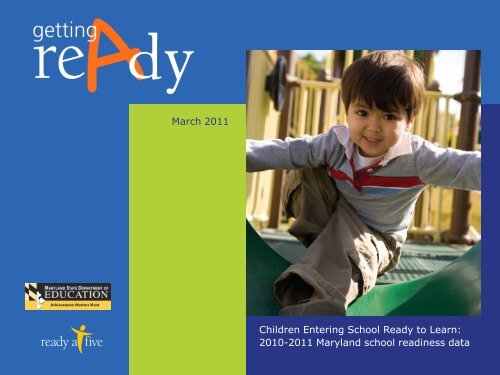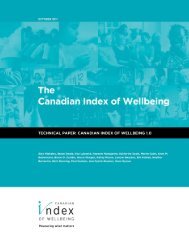The Maryland Model for School Readiness - Community Indicators ...
The Maryland Model for School Readiness - Community Indicators ...
The Maryland Model for School Readiness - Community Indicators ...
Create successful ePaper yourself
Turn your PDF publications into a flip-book with our unique Google optimized e-Paper software.
March 2011Children Entering <strong>School</strong> Ready to Learn:2010-2011 <strong>Maryland</strong> school readiness data
About the MMSRHow <strong>Maryland</strong> Assesses <strong>School</strong> <strong>Readiness</strong><strong>The</strong> <strong>Maryland</strong> <strong>Model</strong> <strong>for</strong> <strong>School</strong> <strong>Readiness</strong> (MMSR)• Assesses what each kindergartener knows and is able to do in the Domains of Learning:• Language & Literacy• Mathematical Thinking• Physical Development• Scientific Thinking• Social & Personal Development• Social Studies• <strong>The</strong> Arts• Children are identified as:• Fully Ready: Consistently demonstrates the skills, behaviors, and abilities, which areneeded to meet kindergarten expectations successfully.• Approaching <strong>Readiness</strong>: Inconsistently demonstrates the skills, behaviors, and abilities,which are needed to meet kindergarten expectations successfully and requires targetedinstructional support in specific areas.• Developing <strong>Readiness</strong>: Student does not demonstrate the skills, behaviors, and abilities,which are needed to meet kindergarten expectations successfully and requiresconsiderable instructional support in several areas.
<strong>Maryland</strong>Demographics
More Children Fully <strong>School</strong>-Ready<strong>Maryland</strong> <strong>Model</strong> <strong>for</strong> <strong>School</strong> <strong>Readiness</strong>, 2010-201132-Point Jump in <strong>Readiness</strong>• 81% of kindergarteners are fullyschool-ready, up from 49% in2001-2002 and 78% last year.• <strong>Maryland</strong> met statisticalprojections.Source: <strong>Maryland</strong> State Department of Education
Sizable Increases Across All Domains<strong>Maryland</strong> <strong>Model</strong> <strong>for</strong> <strong>School</strong> <strong>Readiness</strong>, 2010-2011Major Improvements <strong>for</strong> EachDomain of Learning•Kindergarteners show the greatestone-year readiness gain in the area of:• Scientific Thinking (68% fullyready, up 5 points from 2009-2010).•Kindergarteners demonstrate strongestreadiness in:• Physical Development (88% fullyready in 2010-2011)• <strong>The</strong> Arts (83% fully ready).Source: <strong>Maryland</strong> State Department of Education
Achievement Gains <strong>for</strong> All Children<strong>Maryland</strong> <strong>Model</strong> <strong>for</strong> <strong>School</strong> <strong>Readiness</strong>, 2010-201139-point Increase AmongLow-Income Children•73% of kindergarteners fromlow-income households (asindicated by Free and ReducedPrice Meal status) rose to fullreadiness, up from 34% in2001-2002 and 69% in 2009-2010.•42.3% of kindergarteners arefrom low-income households, upfrom 41.7% in 2001-2002.Source: <strong>Maryland</strong> State Department of Education
Big Improvements Across All Settings<strong>Maryland</strong> <strong>Model</strong> <strong>for</strong> <strong>School</strong> <strong>Readiness</strong>, 2010-2011Gains <strong>for</strong> Children Enrolled inEarly Learning Environments theYear Prior to Kindergarten.•Child care centers saw a 42-point jumpfrom 2001-2002 to 87% fully ready <strong>for</strong>2010-2011.•Public PreK programs experienced a 34-point rise to 81% fully ready.•Family child care experienced a 32-point gain to 77% fully-ready.•Non-public nursery programs saw a 25-point increase to 92% fully ready.Source: <strong>Maryland</strong> State Department of Education
Baltimore CityDemographics
Strong Progress Continues<strong>Maryland</strong> <strong>Model</strong> <strong>for</strong> <strong>School</strong> <strong>Readiness</strong>, 2010-2011Baltimore CityGains Impressive Ground•67% of the City’s kindergartenersare fully ready <strong>for</strong> school in 2010-2011.•<strong>The</strong> City’s kindergarteners arewithin 14 points of the statewidefull readiness level, currently at81%.Source: <strong>Maryland</strong> State Department of Education
Sizable Increases Across All Domains<strong>Maryland</strong> <strong>Model</strong> <strong>for</strong> <strong>School</strong> <strong>Readiness</strong>, 2010-2011Major Improvements• Kindergarteners show the greatest oneyearreadiness gain in the area of:• Scientific Thinking (46% fully ready,up 7 points from 2009-2010).• Kindergarteners demonstrate strongestreadiness in:• Physical Development (79% fullyready in 2010-2011) and• <strong>The</strong> Arts (72% fully ready).Source: <strong>Maryland</strong> State Department of Education
Achievement Gains <strong>for</strong> All Children<strong>Maryland</strong> <strong>Model</strong> <strong>for</strong> <strong>School</strong> <strong>Readiness</strong>, 2010-2011Major Increases Among AfricanAmerican & Hispanic Children•67% of African-Americankindergarteners are fully school-readyin 2010-2011, rising from 27% in2001-2002 and 65% last year.•62% of Hispanic children are nowfully school-ready—a 42-pointreadiness gain from 2001-2002 and13 points more than last year.-Not TrackedSource: <strong>Maryland</strong> State Department of Education
Prior Care Enrollment<strong>Maryland</strong> <strong>Model</strong> <strong>for</strong> <strong>School</strong> <strong>Readiness</strong>, 2010-2011Early Learning Strengthens<strong>School</strong> <strong>Readiness</strong>•Baltimore City enrolled 4,578children in its state-funded PreKprogram in school year 2009-2010(i.e., the year prior to enrollment inKindergarten in school year 2010-2011).•60.9% of the City’s kindergartenparents reported their child’spredominant prior care setting waspublic PreK.NOTE: Some prior care settings have enrollment criteria. For example, HeadStart Centers and public PreK almost exclusively serve children from low-incomehouseholds and children with disabilities—two subgroups that have consistentlyhad significantly lower school readiness than <strong>Maryland</strong> kindergarteners as awhole, and are considered at risk.Source: <strong>Maryland</strong> State Department of Education
PreK Promotes <strong>School</strong> <strong>Readiness</strong><strong>Maryland</strong> <strong>Model</strong> <strong>for</strong> <strong>School</strong> <strong>Readiness</strong>, 2010-2011Higher <strong>Readiness</strong> AmongPreK Children•Kindergarteners who wereenrolled in public PreK programsthe year prior to starting schoolexceed the City’s full readinesslevel.•Kindergarteners enrolled in publicPreK programs (73% fully ready in2010-2011) are better-prepared<strong>for</strong> school than their peers whowere at home or in in<strong>for</strong>mal care(45% fully ready).Source: <strong>Maryland</strong> State Department of Education
Materials <strong>for</strong> Getting Ready 2011 can beaccessed here:http://www.readyatfive.org/facts/mmsr.aspxMiriam Greenleaf-Millermiriam@readyatfive.org410-788-5725



